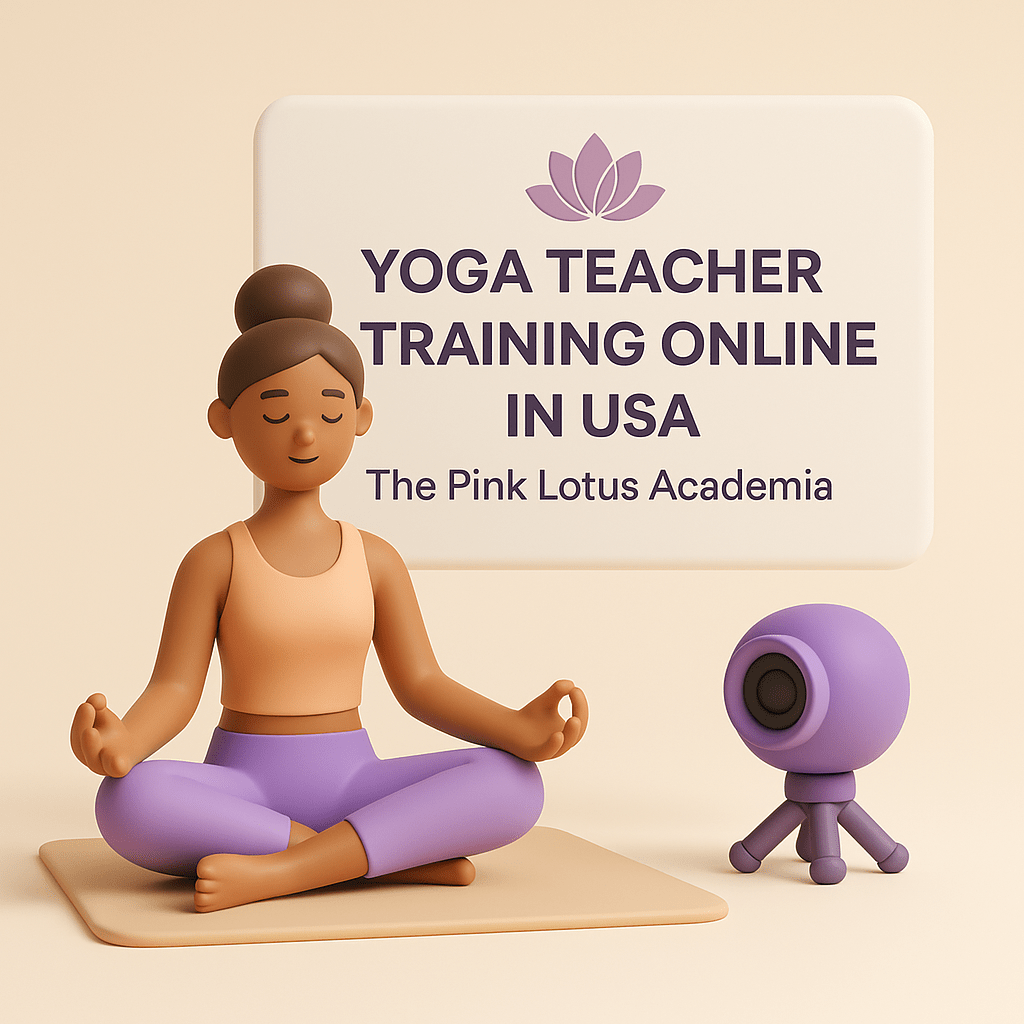How Yoga Helps Managing Stress and Anxiety
Introduction: The Rise of Online Yoga Teacher Training in the USA
In the last few years, yoga has transformed from a wellness trend into a global lifestyle movement. Across the USA, from New York to Los Angeles, more people are turning to yoga for physical strength, mental clarity, and inner balance. Yet, the demands of modern life often make it difficult to attend in-person teacher training programs.
Enter The Pink Lotus Academia — an international yoga institute from New Delhi, India, offering Yoga Teacher Training Online in the USA with world-class technology and personalized mentorship. It bridges the gap between ancient Indian yoga knowledge and global accessibility, empowering students from every corner of America to earn a Yoga Alliance International certification right from home.
Why Choose The Pink Lotus Academia for Online Yoga Certification
Personalized Teaching Through High-End Camera and Audio Setup
Unlike most online yoga classes that rely on a single laptop camera, The Pink Lotus Academia (TPA) employs multi-angle HD camera setups and professional-grade microphones. This ensures that every pose, alignment, and movement is visible with studio-level clarity — allowing teachers to guide students accurately.
One-on-One Mentorship for Every Student
At TPA, yoga training is never generic. Every student receives personalized mentorship tailored to their physical condition, learning pace, and teaching goals. Whether you’re learning Hatha, Vinyasa, or restorative yoga, each session is carefully observed, corrected, and refined.
Global Recognition and 500-Hour Certification
TPA’s online Yoga Teacher Training program is certified by Yoga Alliance International, making it globally valid for teaching opportunities across the USA, UK, Canada, and beyond. Graduates receive a 500-hour certification, recognized by international yoga federations and wellness centers worldwide.
Benefits of Pursuing Yoga Teacher Training Online
Flexibility for Students and Professionals
Busy schedule? No problem. The online TTC offers flexible timings that accommodate students from multiple time zones across the USA. You can complete your certification without leaving your job or daily commitments.
Learn from Indian Yogic Roots
The Pink Lotus Academia is based in New Delhi — the birthplace of yoga’s authentic tradition. Learning directly from Indian yoga masters ensures that your training stays rooted in the original philosophy and spiritual depth of yoga.
Access to Expert Trainers from Anywhere in the USA
From California to Chicago, TPA students join live online sessions conducted by experienced Indian yoga trainers, ensuring you never miss the in-person experience despite the digital format.
The Pink Lotus Academia – Transforming Yoga Education Globally
About the Institute
Founded in Greater Kailash-II, New Delhi, The Pink Lotus Academia is a holistic arts and wellness institution combining Yoga, Aerial Yoga, Classical Music, and Dance under one roof.
Vision and Philosophy
The institute envisions a world where wellness education is accessible, inclusive, and empowering. TPA’s philosophy emphasizes authentic learning, compassion, and self-awareness as key pillars of transformation.
Student-Centric Learning Environment
Each student receives a nurturing environment — not just to learn yoga but to live it. The classes are designed to promote spiritual growth alongside physical mastery, cultivating true yogic wisdom.
Course Structure of Online Yoga TTC by The Pink Lotus Academia
200-Hour Foundation Level
Perfect for beginners, this level introduces you to yoga basics, including postures, breathing techniques, and meditation. Students learn to develop discipline and foundational teaching skills.
300-Hour Advanced Level
At this level, you dive deeper into anatomy, alignment, and advanced asanas. The course also focuses on pranayama, sequencing, and yoga teaching ethics.
500-Hour Complete Yoga Teacher Certification
Combining the 200-hour and 300-hour modules, the 500-hour TTC is the most comprehensive course offered online. Graduates emerge as confident, globally certified yoga instructors ready to teach worldwide.
What Makes TPA Different from Other Online Yoga TTCs
Live Interactive Sessions
Every class at TPA is live and interactive — no pre-recorded lessons. Students can ask questions, receive feedback, and experience real-time correction.
Practical Demonstrations with HD Camera Setup
Multiple cameras ensure that students can observe every alignment and posture from different angles. The sessions feel immersive, almost as if you’re attending an in-studio class.
Recorded Backup of All Classes
Missed a session? You can rewatch it later. Every class is recorded in high-quality video and shared privately with students for lifelong reference.
Key Modules Covered in Online Yoga TTC
Asana and Alignment Training
Learn over 70 postures in detail, with emphasis on correct body alignment, safety, and sequencing.
Pranayama and Breathwork Techniques
Breathwork is the bridge between the mind and body. You’ll master pranayama techniques like Kapalabhati, Anulom Vilom, and Bhramari for mental clarity and vitality.
Yoga Anatomy and Physiology
Understand how muscles, joints, and organs interact during yoga. This module builds your awareness of safe teaching practices.
Philosophy, Meditation, and Teaching Practice
Delve into Patanjali’s Yoga Sutras, mindfulness meditation, and live teaching simulations to prepare you for a professional career.
Who Can Enroll for the Online TTC Program in USA
Beginners and Intermediate Practitioners
Whether you’re starting your yoga journey or want to deepen your practice, the course is designed for all levels.
Fitness Trainers and Health Coaches
Many fitness experts in the USA join TPA’s online TTC to integrate yoga into their wellness training programs.
Homemakers and Working Professionals
TPA’s flexible timing allows women and professionals to learn yoga without disrupting daily routines.
Certification and Accreditation
Upon completion, students receive a Yoga Alliance International-accredited certificate. This globally recognized credential allows you to teach in studios, wellness retreats, and online platforms around the world.
Success Stories of Global Students
Students from California, Texas, Florida, and New York have shared inspiring stories of transformation through TPA’s online TTC. Many have launched their own yoga studios or online teaching careers after completing the certification.
How to Apply for the Online TTC at The Pink Lotus Academia
Step-by-Step Admission Process
Choose your preferred batch and course duration
Fill in the enrollment form and schedule your consultation call
Complete payment and start your journey
Fee Structure and Batch Timings
200-Hour TTC: 6 weeks
300-Hour TTC: 8 weeks
500-Hour TTC: 12 weeks
Morning and evening batches are available for USA time zones.
FAQs About Online Yoga Teacher Training in USA
1. Is this certification valid in the USA?
Yes. TPA’s certification is internationally recognized and valid across the USA and other Yoga Alliance-affiliated countries.
2. Do I need prior yoga experience to join?
No, beginners are welcome. The course is structured to guide you from basics to advanced levels.
3. How are the classes conducted?
All sessions are live via high-definition video conferencing with multi-angle cameras.
4. Will I receive recordings of my classes?
Yes, recordings are provided for lifetime access.
5. Can I teach yoga professionally after completing the course?
Yes. The certification qualifies you to teach globally, both online and offline.
6. What if I miss a class due to time zone difference?
You’ll receive recorded sessions and personalized guidance to catch up easily.
Conclusion: Empowering Global Yoginis through The Pink Lotus Academia
In a world that’s constantly changing, The Pink Lotus Academia bridges ancient Indian wisdom with modern digital learning. The Yoga Teacher Training Online in USA program offers an unmatched blend of authenticity, technology, and personalized attention.
With its high-end camera setup, interactive teaching, and Yoga Alliance-certified curriculum, TPA stands as the best online yoga institute for women and professionals across the globe. Enroll today and begin your journey toward becoming a confident, compassionate, and certified yoga teacher.
Learn More: Contact Us
Social: Instagram













